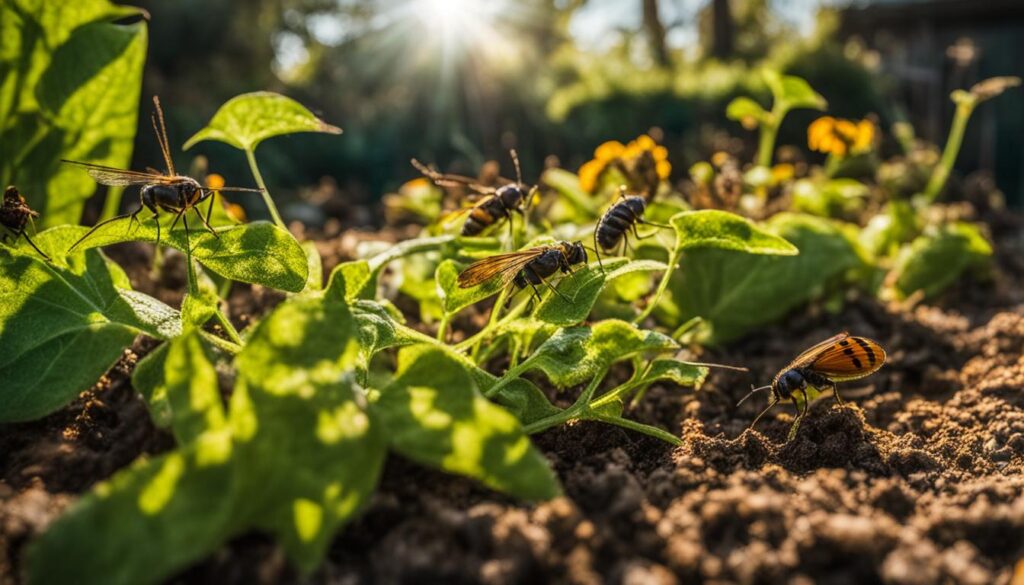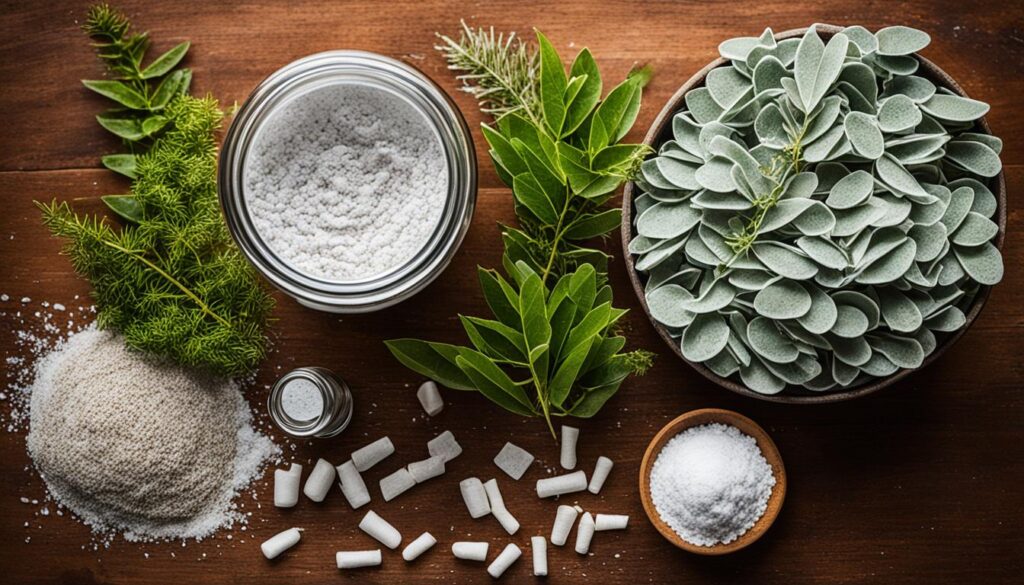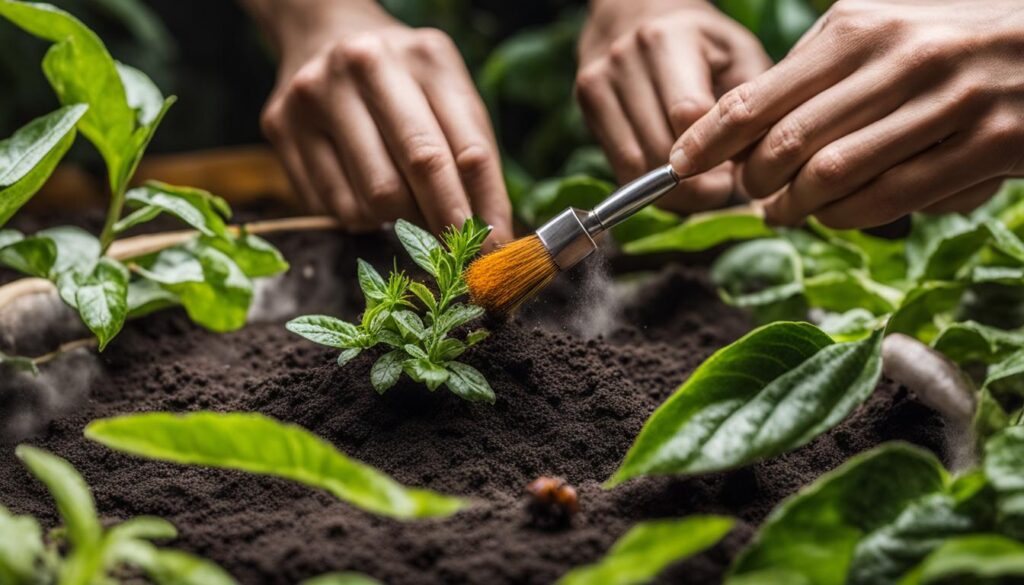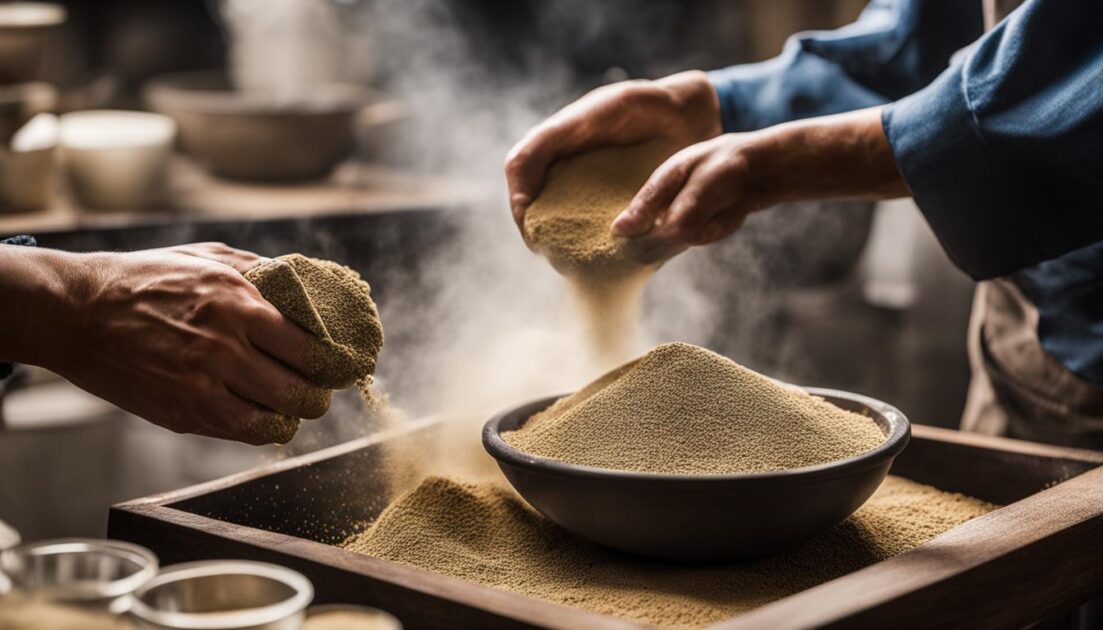I’m excited to share with you a step-by-step guide on how to make your own diatomaceous earth at home. Diatomaceous earth (DE) is a natural pesticide that can effectively control insects in your garden. By creating your own homemade diatomaceous earth, you can embrace natural living and avoid the use of store-bought chemicals.
Key Takeaways:
- Learn how to make diatomaceous earth at home and take control of your pest management in a natural and sustainable way.
- Discover the benefits of using diatomaceous earth as an insecticide and why it is a popular choice among gardeners.
- Follow a simple recipe that involves common ingredients to create your homemade diatomaceous earth insecticide.
- Gain insights into the application process and tips for using diatomaceous earth effectively to protect your plants.
- Stay safe while handling diatomaceous earth by taking precautions and using food-grade DE for pest control purposes.
Why Use Diatomaceous Earth as an Insecticide?
When it comes to combating insects in your garden, diatomaceous earth (DE) is a top choice. This natural and non-toxic alternative to chemical pesticides offers numerous benefits and advantages that make it a popular option among gardeners. Whether you’re concerned about the safety of your family, pets, and the environment or you want to preserve beneficial insects, diatomaceous earth provides a reliable solution.
One of the key benefits of diatomaceous earth as an insecticide is its safety. Unlike chemical pesticides that can be harmful to humans and animals, DE poses no significant risks. It is a naturally occurring substance made from fossilized algae called diatoms, and it does not leave behind harmful residues. This means you can use diatomaceous earth in your garden without worrying about the negative effects on your health or the well-being of your loved ones.
Not only is diatomaceous earth safe, but it also does not harm beneficial insects. Many chemical pesticides indiscriminately kill all insects, including those that are beneficial for pollination and pest control. In contrast, DE targets specific pests while leaving beneficial insects unharmed. This allows you to protect your plants from harmful insects without disrupting the delicate balance of your garden ecosystem.
Furthermore, diatomaceous earth is highly effective against a wide range of pests. It works by physically damaging the exoskeletons of insects, leading to their dehydration and eventual death. This means that diatomaceous earth can help control common garden pests such as aphids, thrips, whiteflies, and many more. Its broad spectrum of effectiveness makes it a versatile and practical choice for insect control.
With these advantages in mind, it’s easy to see why diatomaceous earth is a preferred option for insect control in the garden. Its natural and non-toxic properties, along with its effectiveness and safety for beneficial insects, make it a valuable tool in maintaining a healthy and thriving garden ecosystem.

Benefits of Diatomaceous Earth as an Insecticide:
- Safe for humans, animals, and the environment
- Does not harm beneficial insects
- Effective against a wide range of pests
- Naturally occurring and non-toxic
- No harmful residues
Making Diatomaceous Earth Insecticide at Home
Making your own diatomaceous earth insecticide at home is a cost-effective and eco-friendly solution for controlling pests in your garden. With just a few simple ingredients, you can create a powerful insecticide that is safe for both plants and the environment. Follow this step-by-step diatomaceous earth guide to create your homemade diatomaceous earth insecticide.
Ingredients:
- Diatomaceous Earth: The main component of the insecticide, diatomaceous earth acts as a natural pest control agent by dehydrating and killing insects.
- Neem Oil: Adding neem oil to the mixture enhances the effectiveness of the insecticide. Neem oil has insecticidal properties and helps repel pests.
- Dish Soap: Dish soap acts as a surfactant, helping the ingredients mix together and adhere to the plants’ foliage.
- Water: Water is used to dilute the solution for easy application.
Combine the ingredients as follows:
- Mix 1 cup of diatomaceous earth with 1 tablespoon of neem oil in a container.
- Add 1 teaspoon of dish soap to the mixture.
- Slowly pour in 1 gallon of water while stirring the mixture.
- Continue stirring until all the ingredients are well combined.
Your homemade diatomaceous earth insecticide is now ready to use. The following table summarizes the ingredients and their purpose in the recipe:
| Ingredient | Purpose |
|---|---|
| Diatomaceous Earth | Dehydrates and kills insects |
| Neem Oil | Enhances effectiveness and repels pests |
| Dish Soap | Acts as a surfactant for mixing and adhesion |
| Water | Dilutes the solution for easy application |
With this simple DIY diatomaceous earth recipe, you can now take control of garden pests while embracing a natural and sustainable approach. Apply the insecticide to your plants as needed to keep them free from harmful insects.

How to Apply Diatomaceous Earth Insecticide
When it comes to combating insects in your garden, applying diatomaceous earth (DE) insecticide is an effective and natural solution. By using this powerful compound, you can protect your plants from pests without resorting to harsh chemicals. In this section, I will guide you through the process of applying diatomaceous earth insecticide and share some valuable tips for using it effectively in your garden.
Applying Diatomaceous Earth Insecticide
To apply diatomaceous earth insecticide, you have a few options. You can use a spray bottle for precise targeting or a container with a sprinkler attachment for widespread coverage. Whichever method you choose, it is crucial to ensure that you are applying the insecticide correctly to maximize its effectiveness.
Here is a step-by-step guide to help you apply diatomaceous earth insecticide:
- Test a small area: Before applying the insecticide to your entire garden, it is essential to test a small area of your plants. This will help you determine if the diatomaceous earth causes any damage or adverse reactions. Apply a small amount of the insecticide to a few leaves and monitor the plants closely for any negative effects.
- Focus on affected areas: Once you have confirmed the safety of the insecticide, you can proceed to treat the affected areas. Identify the foliage and plants where insects are present and concentrate your diatomaceous earth application on those specific areas. This targeted approach will ensure that the insecticide reaches the pests directly, increasing its efficacy.
- Choose the right time: Timing is crucial when applying diatomaceous earth insecticide. It is best to spray the insecticide in the evening or early morning when the sun is not shining directly on the plants. This helps prevent the insecticide from drying out too quickly and allows it to stay effective for longer periods.
- Avoid watering or rain: After applying diatomaceous earth insecticide, it is important to avoid watering your plants or exposing them to rain for a few days. Water can wash away the insecticide, reducing its potency. Be mindful of the weather forecast and plan your application accordingly to ensure optimal results.

Tips for Using Diatomaceous Earth in the Garden
To make the most out of diatomaceous earth insecticide in your garden, consider these additional tips:
- Wear protective gear: Diatomaceous earth can be irritating if inhaled or if it comes into contact with your skin. Wear a dust mask and gloves to protect yourself while handling and applying the insecticide.
- Use food-grade diatomaceous earth: For pest control purposes, it is recommended to use food-grade diatomaceous earth. This type of diatomaceous earth is safe for both humans and animals while serving as an effective insecticide.
- Monitor for sensitivities: Regularly inspect your plants for any signs of sensitivity or damage from the insecticide. If you notice any adverse effects, discontinue use immediately and seek alternative methods.
- Properly store diatomaceous earth: To maintain the effectiveness of diatomaceous earth, store it in a cool, dry place away from moisture. This will help preserve its insecticidal properties, ensuring it remains potent for future use.
By following these guidelines, you can confidently apply diatomaceous earth insecticide in your garden and protect your plants from unwanted pests in an eco-friendly and non-toxic way.
Precautions and Tips for Using Diatomaceous Earth Insecticide
When using diatomaceous earth as an insecticide, it’s essential to prioritize safety measures to ensure the well-being of both yourself and your plants. The first precaution to keep in mind is to avoid inhaling the dust of diatomaceous earth, as it can be harmful to your lungs. To protect yourself, it is recommended to wear a dust mask and gloves during the handling and application of the insecticide. By taking these simple steps, you can minimize any potential risks.
Another important aspect to consider is the quality of the diatomaceous earth you are using. To effectively control pests in your garden, it is advisable to opt for food-grade diatomaceous earth. This type of diatomaceous earth is safe for plants, humans, and animals, ensuring no harm is done to your garden ecosystem. By choosing the right grade, you can have peace of mind knowing that you are using a non-toxic and environmentally-friendly solution.
In addition to safety precautions, it is crucial to monitor your plants regularly when using diatomaceous earth as an insecticide. Some plants may be more sensitive than others, and it’s important to watch out for any signs of damage or sensitivity. If you notice any adverse effects, such as wilting or discoloration, it is best to discontinue the use of the insecticide immediately to prevent further harm to your plants.
Lastly, proper storage of diatomaceous earth is essential in maintaining its effectiveness. Store the product in a cool, dry place to prevent moisture accumulation, which can diminish its insecticidal properties. By following these precautions and tips, you can confidently use diatomaceous earth as an effective and safe solution for pest control in your garden.
FAQ
What is diatomaceous earth and how does it work as an insecticide?
Diatomaceous earth is a natural pesticide made from crushed diatoms, a type of fossilized algae. It works by absorbing lipids from insects’ exoskeletons, causing them to dehydrate and die.
Why should I use diatomaceous earth as an insecticide?
Diatomaceous earth is a safe and non-toxic alternative to chemical pesticides. It is effective against a wide range of pests and does not harm beneficial insects or the environment.
How do I make diatomaceous earth insecticide at home?
To make your own diatomaceous earth insecticide, you will need diatomaceous earth, neem oil, dish soap, and water. Mix the ingredients together and dilute with water for easy application.
How do I apply diatomaceous earth insecticide?
You can apply diatomaceous earth insecticide using a spray bottle or a container with a sprinkler attachment. Test a small area of your plant before applying and spray directly on the affected foliage.
Are there any precautions I should take when using diatomaceous earth insecticide?
It is important to avoid breathing in the dust of diatomaceous earth and to wear a dust mask and gloves when handling and applying the insecticide. Use food-grade diatomaceous earth and monitor your plants for any adverse effects.






